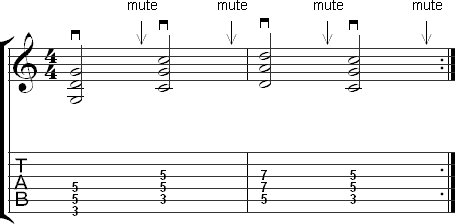What You Should Know
What You Will Learn
- How to palm mute power chords
- How to mute for cleaner playing, rests, and staccato
How to Palm Mute Power Chords
What is Muting?
Muting is a technique that is used to prevent the strings from ringing after a note or chord has been played. Muting may also be used to alter the sound by muting the strings in such a way that they can still sound, but the resulting sound is muffled. These techniques are used frequently in rock, heavy metal, and other styles, so it is important to learn them.
Palm Muting
How to Palm Mute
Palm muting is a technique where the strings are muted with the palm of the hand, producing a muffled sound. The palm is lightly rested on the strings where they meet the bridge.
Don't Use Pressure
It is very important that you are not exerting any pressure on the strings. Depending on the kind of bridge your guitar has, any pressure could cause the pitch to go sharp. Pressure may also cause tension in your right arm, which will limit your technique. Your palm only needs to be touching the string to mute them.
Position of the Hand
The position of the hand will change the amount of muting. Moving the palm closer to the bridge will produce a sound that is less muted, while moving in the opposite direction will produce a more muted sound. Experiment with moving the palm around to see how the sound changes. Be careful to not move too far away from the bridge or you will completely mute the string.
Palm muting for power chords generally works better with all downstrokes, although it is possible to play upstrokes too.
How Palm Muting is Notated
Palm muting is indicated by placing P.M. over the notes or chords to be palm muted.

If the palm muting applies to several chords in a row, a dotted line will be placed after P.M. with a line at the end to indicate that the palm muting should not be applied to anything after that.
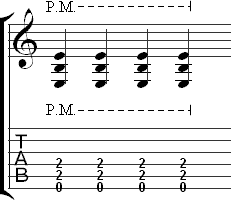
Exercises
Exercise 1
Exercise 1 features an E5 chord in quarter notes with each of the chords muted. Practice very slowly and use this exercise as an opportunity to find the ideal position for muting. This may vary due to several factors, including the size of your hand, the type of guitar you have, and the gauge of strings you are using. You need to experiment to find what works for you.
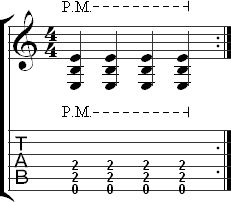
Exercise 2
Exercise 2 mixes palm muted chords with chords that are played normally. You need to raise your palm off the strings slightly to play the chords that aren't muted so that the strings can ring freely. Work on making the switch between muted and non-muted chords as smooth as possible.
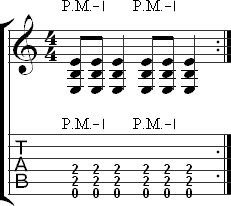
Muting for Staccato
It is also important to be able to mute a power chord to make it stop sounding after you have played it. This facilitates things like rests and staccato. Like palm muting, this kind of muting is also done with the palm. Simply place your palm on the strings to stop the sound. You will need to experiment with the exact position of your hand to determine what works for you.
Exercise 3
Exercise 3 is an exercise in using muting to play chords staccato. Each chord should be played and then muted with the right hand before the chord rings for its full value. Experiment with different degrees of staccato. For example, mute immediately after playing the chord for a very short staccato or allow the chord to ring for almost its full value before muting for a less pronounced staccato. The exercise below is shown with an E5 chord, but you should try this muting technique with other chords.
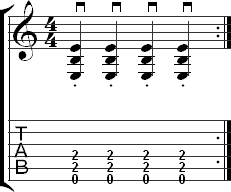
The table below shows three degrees of staccato that can be used to practice Exercise 3. These variations are somewhat advanced because you need to be able to count sixteenth notes in order to play them correctly.
| Description | Example | Notes |
|---|---|---|
| Slight Staccato | 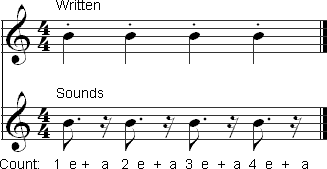 |
In this staccato, each quarter note is shortened by one sixteenth note. Play this by muting on the "a". You need to count continuously to play this properly. |
| Medium Staccato | 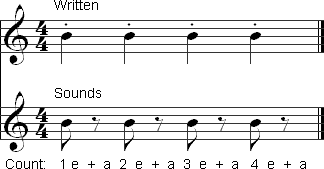 |
Play a medium staccato by muting on the "and" of each beat. |
| Staccatissimo | 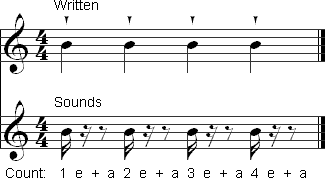 |
Staccatissimo is a very short staccato that is indicated by wedges rather than dots. Play this by muting on the "e" of every beat. |
The staccato exercises above could have been written with rests instead of staccato markings. The same muting technique can be used regardless of whether the rhythm is written out explicitly or staccato markings are used.
Muting During Rests
Muting can also be used to silence the strings during rests. The strings should be muted at the start of a rest. The palm needs to continue touching the strings until the end of the rest. It is as important to silence the strings when they are ringing as it is to prevent any sound during the rest.
Exercise 5
Exercise 5 will help you learn this technique. Allow each chord to ring for its full duration, then mute the strings at the start of each rest. Rest your palm on the strings until it is time to strum the next chord.
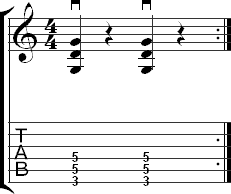
Muting for Cleaner Technique
Muting can also be used to make your playing cleaner when switching between chords. This kind of muting prevents the open strings from ringing as you make the switch. Lifting your fingers off the strings when moving to the new chord will usually cause the strings to ring. Muting prevents this. You need to be careful with this technique, since you do need to shorten the value of each chord slightly. Don't shorten the value so much that it sounds like a staccato. You only need enough time to make the switch to the new chord.
Another benefit of lifting your fingers off the strings when switching chords is that it is easier to avoid string noise. With the exception of the open power chord voicings, most power chords have the same fingering. This makes it tempting to just slide along the strings. Unfortunately, this causes string noise that is generally undesirable. Lifting your fingers off the strings when switching prevents this noise. This is a more difficult way to switch between chords, but it will make you a better player.
Exercise 4
Exercise 4 can be used to practice this technique. Start by playing the G5 chord. Hold it for nearly its full value and then mute the strings to silence them. As you are muting, you should be simultaneously lifting your left hand fingers off of the fretboard and moving to the C5 chord. Play the C5 chord as you lift your palm off of the strings. This should be one smooth motion. Follow this procedure for the entire exercise.
